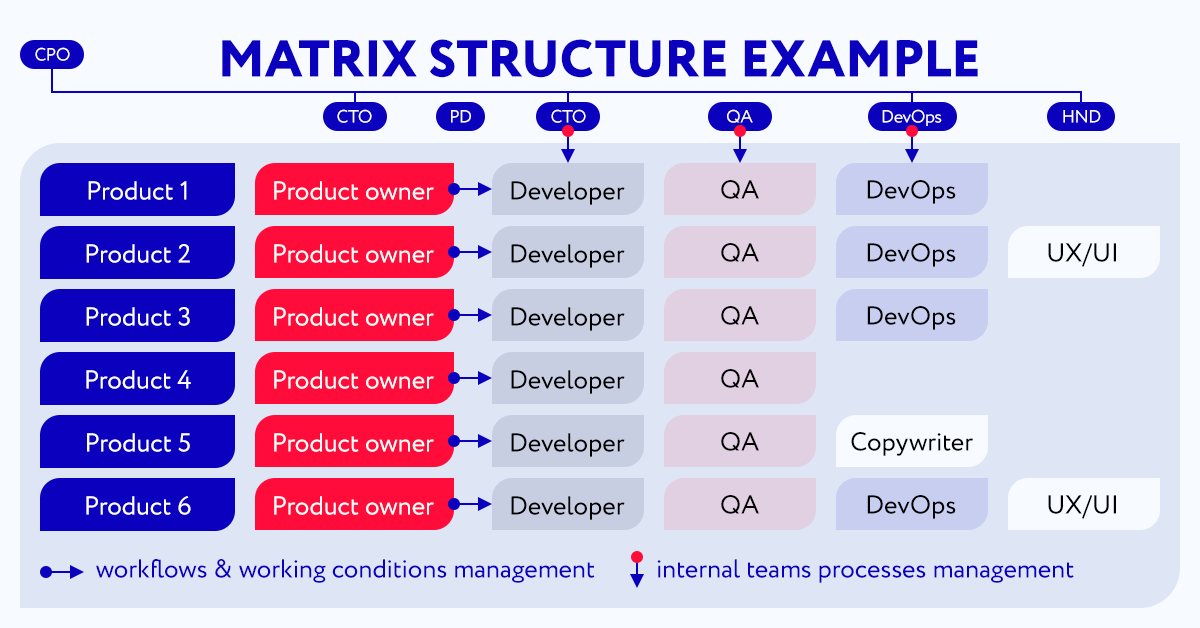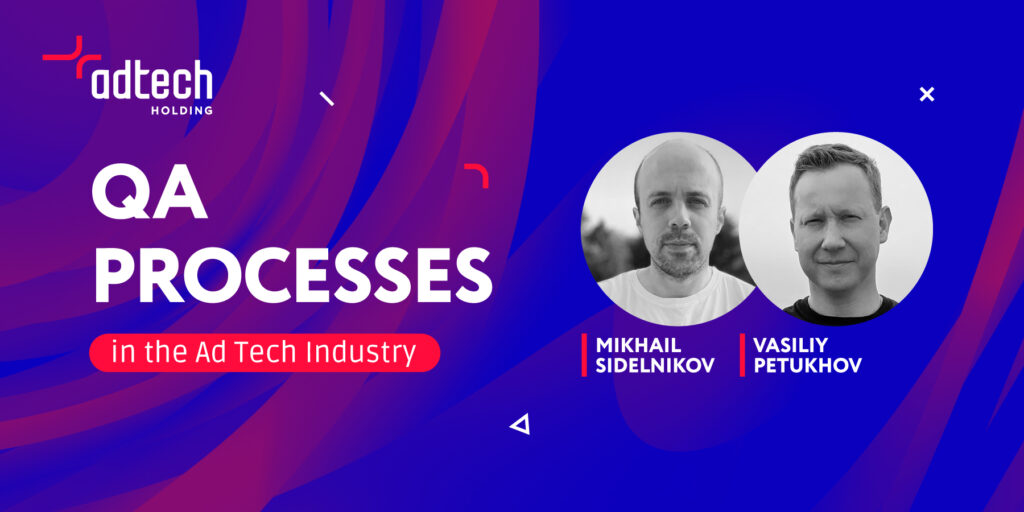Structural Odyssey: AdTech Holding Approach to Product Teams Formation

Many businesses tend to step back from classical hierarchical structures, where employee teams are subordinate to a single boss. One of the biggest reasons for this is the rigidity of such organizational frameworks: they don’t always allow a quick change in the structure according to current business needs.
In the example of PropellerAds, a multisource ad network, and the flagship AdTech Holding project, we will show you an alternative way to organize processes, product team formation, and management at a large company working in one of the most rapidly changing industries.
Before We Begin: Introduction to PropellerAds
The current structure of PropellerAds and other AdTech Holding projects can be called ‘matrix’ — it is one of the four commonly accepted organizational hierarchies.
Besides, we will also use various terms related to modern frameworks, so let’s explain them right away to make the whole piece clear for you. Finally, we will show you around PropellerAds’s organization — to guide you through its evolution from the beginning to the present.
Glossary
- Matrix structure. In a nutshell, this is an organizational structure where teams report to multiple managers. At the same time, the responsibilities for team management are shared between two or more leaders.

- Waterfall model. A project management practice with a linear approach: when the project is completed step-by-step, from the beginning to the end (for example, from planning to release).
- Gantt Chart. A visual method of planning projects — in simple terms, a diagram showing tasks and performance time planned for each.
- Agile. A project management approach that implies dividing a project into short phases called sprints. This enables continuous iterations and a quicker delivery of each phase.
- Scrum. Scrum is one of the Agile methodologies, implying self-organized teams, breaking work into smaller phases, called sprints — with regular sprint reviews and feedback.
- Kanban. Another Agile methodology based on the visual representation of tasks with the help of Kanban boards.
Product Teams Evolution
For many years, PropellerAds has been a standalone brand. Then, the AppLabz was launched — it evolved from a project idea at our internal hackathon.
Based on AppLabz’s experience, we developed a golden rule for all the new projects we want to implement.
Here is the rule: all the new projects must be created within a step from our current products. This means any initiative must be based on our existing expertise and have a competitive advantage.
This way, we opened Notix — based on our unique push notifications technology; ProPush — extra monetization with Push notifications, AdEx — an anti-fraud tool for advertisers; and ZeyDoo — a CPA network.
All these projects base their product teams formation on a similar approach and adopt the principles built by PropellerAds. Still, various departments might have different structures — for example, some projects, like Notix, have dedicated product teams, while some do not.
Overall, the main principle is to remain agile. Depending on the project, AdTech Holding projects use different organizational structures to stay flexible and, if necessary, implement quick changes.
How it started: from Waterfall to Agile
PropellerAds was a small startup with several teams, mainly developers and sales managers.
At first, it didn’t have any particular structure. The project involved several people, and basically, everyone was responsible for different aspects of startup development, as it is traditionally done in new projects. Later, it began forming a structure: the work was divided into projects, with project managers in charge of each.
Then, as the company grew, the approach was changed to products instead of projects — with a dedicated team around each product. The workflows were organized differently, but the main methods included a Waterfall model, with Gantt charts for visualizing the processes.
How The Product Teams Became Agile
The Agile Manifesto began gathering pace in the 2010s — many international companies tended to refuse traditional waterfall models. The successful experience of other brands that PropellerAds witnessed at conferences and during networking activities inspired us to change.
Thus, PropellerAds began its fundamental work on adopting Scrum. It involved guest Scrum coaches we invited to help us and change the whole process within the teams.
Konstantin Kuznetsov, the Chief Product Officer:
The experience with invited coaches is definitely useful — but it’s essential to understand that no coach can perform 100% of the work for you. It is hard for a third-party person to get fully absorbed into the existing processes of a particular business. So their job is to come up with the right mechanics, while the teams must integrate them into the workflows correctly. Thus, we also passed certifications on the Scrum Product Management and invested a lot into team onboarding to turn them into self-organized structures.
Gradually, the company adopted Scrum and restructured the processes to become a matrix organization. Here is how it looks in various teams today.
Product Teams Structure
Teams responsible for product development are managed from two sides:
- IT management — a servant leadership block. It does not manage or rule the teams but creates the right conditions for smooth workflows. Its main aim is to deliver the company’s goals in a timely manner and ensure the teams find the growth points without any involvement of the managers.
- Product Management — each team has a product manager who operates as a supervisor. Unlike IT managers, POs are not responsible for the professional development of team members.
Here is an example: the Head of QA is responsible for all the QA employees and processes. He can reorganize the QA teams, help employees develop and grow, and become involved in the hiring process when new engineers are required.
However, he does not manage the internal QA team processes: each product has its own QA team led by a Product Owner.
Here is how it works on the example of QA:

Such a product teams formation approach allows PropellerAds to scale to any size. The main logic behind it is that all teams are self-organized, and every member feels responsible for the product and its quality. This is why we strive to hire exclusively Senior-level specialists or grow professionals within its internal hub.
The only exception to this are the teams with a constant incoming stream of tasks — like Technical Support They apply Kanban processes as they have a constant incoming stream of tasks — and PropellerAds hires Junior specialists for them. Later, they are transferred to other product teams as Middle or Senior professionals.
Other Teams
The other teams can work in a different way — but the matrix structure is kept for most departments.
For example, the Sales teams of the commercial block have team leaders. They basically carry the same responsibilities as the other team members but have more extensive expertise and can also be responsible for learning and skill-sharing. Besides a team leader, the teams are managed by Heads of Departments — for example, a Head of Business Development.
What Did We Learn From Our Projects Experience?
Our biggest advantage is the agile approach and flexibility. In the example of the QA team we showed you above, you can see that the teams can be quickly rearranged in the way required right at the moment.
Here are the main takeaways from PropellerAds’s existing structure:
- Self-organized teams around the products are the best way to grow and implement new strategies. When each team member is excited to notice problems and find solutions, the product experiences quick, constant growth and improvement.
- Investing in Junior specialists and integrating them into processes is a proven way to grow dedicated and expertized professionals. Propeller’s current structure allows it to do this smoothly and give all Juniors a chance for promotion and professional development.
As Konstantin Kuznetsov puts it, PropellerAds’s structure today fully meets its business needs — and it keeps working on improving the current processes. Thanks to its organization flexibility, any change is smooth enough to boost and never slow down any workflows.





